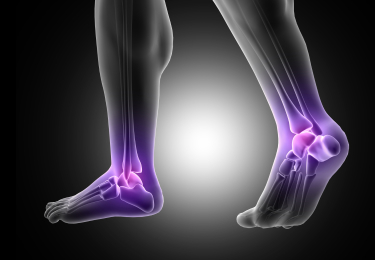Ankle Sprain
Specialist In Singapore

Dr Chiam Tut Fu

MBBS (Singapore)
MSS (Sports Medicine) (USA)
MMed (OM) (Singapore)
GDOM (Singapore)
DWD (Singapore)

What Is An Ankle Sprain?
An ankle sprain is a common injury that occurs when the ankle is twisted or turned in an awkward way, causing the ligaments that hold the ankle bones together to stretch or tear. Ankle sprains are particularly prevalent among athletes and individuals who engage in physical activities that involve jumping, running, or fast changes in direction.

Causes of Ankle Sprains
- Sudden Twisting or Rolling: Ankle sprains often occur when the foot is planted awkwardly, causing the ankle to twist or roll. This can happen during sports, while walking on uneven surfaces, or during a fall.
- Collision Impact from Sports: Sports that involve jumping, swift changes in direction, or contact with other players, such as basketball, football, or soccer, can lead to ankle sprains.
- Previous Ankle Injuries: Having a previous ankle sprain increases the risk of future sprains due to weakened ligaments and muscles around the ankle.

Symptoms of Ankle Sprains
- Pain: This is typically immediate and can be severe, depending on the extent of the injury.
- Swelling: The ankle may swell due to inflammation and increased fluid in the tissue.
- Bruising: This may occur soon after the injury.
- Limited Range of Motion: Difficulty moving the ankle, particularly in trying to rotate or bend it, is common.
- Instability: In severe sprains, the ankle may feel unstable, as if it will give way.
Types of Ankle Sprains
-
Grade I Sprain
A mild sprain where the ligaments are stretched but not torn. There is minimal swelling and pain, and the ankle is still stable.
-
Grade II Sprain
This is a moderate sprain where the ligaments are partially torn. There is noticeable swelling and bruising, and the ankle may feel unstable.
-
Grade III Sprain
The most severe sprain where the ligaments are completely torn. The pain, swelling, and instability are significant, and walking can be difficult.

Diagnosis of Ankle Sprains
-
Physical Examination
The doctor will examine the ankle, foot, and lower leg, and may move the ankle in various ways to check the range of motion and determine the severity of the sprain.
-
Imaging Tests
X-rays can rule out any broken bones, while an MRI or ultrasound can provide a more detailed view of the ligaments to assess any damage.
-
Functional Tests
These may be used to evaluate the ankle's stability and the patient's ability to walk or bear weight.
Minimally Invasive Treatments We Use To Treat
Ankle Sprains
An injection that alleviates pain and inflammation associated with musculoskeletal conditions such as arthritis, bursitis, tendinitis and joint pain.
Targeted pain relief in the administered area and reduced inflammation.
Little to no recovery time. Patients may resume their normal activities promptly.
Works well in chronically injured tissues which may have very slow recovery
Anti-inflammatory and regenerative effects
Little or no downtime and patients can walk out after the 30 min procedure
Treats flare-ups of OA pain and swelling with fluid buildup in the knee
Reduces inflammation in the joint
Can quickly relieve these symptoms, usually within 1-3 days
Uses low-level light to stimulate healing. Does not cause your tissues to heat up. LLLT is used to treat various musculoskeletal conditions, reduce inflammation, and promote wound healing.
Painless, Quick, Effective, and No downtime. Patients can return to their normal activities immediately after an LLLT session.

Dr Chiam Tut Fu 
(詹达夫医生)
MBBS (Singapore)
MSS (Sports Medicine) (USA)
MMed (OM) (Singapore)
GDOM (Singapore)
DWD (Singapore)
Dr Chiam is a MOH accredited Specialist in Sports Medicine and has practised medicine for over 30 years.
Dr Chiam Tut Fu obtained his MBBS from National University of Singapore in 1990. He went on to obtain his Masters in Sports Science (Sports Medicine) from the United States Sports Academy, graduating as the year’s outstanding student, and Masters of Medicine (Occupational Medicine) from the National University of Singapore.
Key Interests:
- Non-surgical treatment of sports injuries
- Non-surgical treatment of degenerative conditions
- Nutraceuticals for healthy ageing and exercise performance
Need Advice On Your Condition?
Do you have an enquiry about your sports injury or body joint condition? Please leave us a message and we will be in touch with you shortly.
Mon to Fri: 9:00am – 1:00pm
2:00pm – 6:00pm
Sat: 9:00am – 1:00pm
Sun & PH: Closed
Singapore Paincare Center
Paragon Medical Centre, #18-03
290 Orchard Road, Singapore 238859
Partnered Programs & Insurance Plans
For Singaporeans, Singapore Permanent Residents and Foreigners.
Please speak to our friendly clinic staff about using your insurance plans.
Frequently Asked Questions
Can I walk on a sprained ankle?
Whether you can walk on a sprained ankle depends on the severity of the sprain. For mild sprains, you may be able to walk with some discomfort. For more severe sprains, walking may be too painful or physically impossible.
How long does it take to recover from an ankle sprain?
Recovery time for an ankle sprain can vary depending on the severity of the sprain. Mild sprains may heal in a few weeks, while severe sprains may take several months to fully heal.
Can an ankle sprain heal on its own?
Yes, an ankle sprain can heal on its own with proper care and rest. See a ankle sprain specialist in Singapore to ensure proper healing and prevent complications.
What exercises can I do to rehabilitate a sprained ankle?
Rehabilitation exercises for a sprained ankle can include range of motion exercises, strengthening exercises, and balance and control exercises.